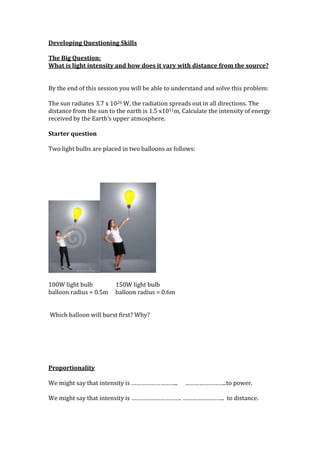Developing questioning skills light intensity
•Descargar como DOCX, PDF•
0 recomendaciones•583 vistas
Denunciar
Compartir
Denunciar
Compartir

Recomendados
Recomendados
Más contenido relacionado
Similar a Developing questioning skills light intensity
Similar a Developing questioning skills light intensity (16)
Principle of Derivative Calculus - Differential Calculus - An Introduction by...

Principle of Derivative Calculus - Differential Calculus - An Introduction by...
Brightness at Varying Distances LabImage by Borb CC license.docx

Brightness at Varying Distances LabImage by Borb CC license.docx
Anekwe's Corrections on the Negative Binomial Expansion

Anekwe's Corrections on the Negative Binomial Expansion
Más de jorawlings
Más de jorawlings (20)
Developing questioning skills light intensity
- 1. Developing Questioning Skills The Big Question: What is light intensity and how does it vary with distance from the source? By the end of this session you will be able to understand and solve this problem: The sun radiates 3.7 x 1026 W, the radiation spreads out in all directions. The distance from the sun to the earth is 1.5 x1011m, Calculate the intensity of energy received by the Earth’s upper atmosphere. Starter question Two light bulbs are placed in two balloons as follows: 100W light bulb 150W light bulb balloon radius = 0.5m balloon radius = 0.6m Which balloon will burst first? Why? Proportionality We might say that intensity is ……………………….. ……………………..to power. We might say that intensity is …………………………. …………………….. to distance.
- 2. Possible Relationships for how intensity varies with distance Inverse y = 1/x Inverse square y = 1/x2 On the two graphs above plot: x value y=1/x values y=1/x2 value 0.25 4 16 0.5 2 4 1 1 1 2 0.5 0.25 4 0.25 0.125 8 0.125 0.016 How are the graphs different?
- 3. Practical The aim of your experiment is to determine 1. Which of these graphs is correct and then to work out the formula for light intensity. What is the formula for light intensity? Intensity = _______________________ 2. Which balloon on the starter will burst first? 3. Can you solve the original question now? The sun radiates 3.7 x 1026 W, the radiation spreads out in all directions. The distance from the sun to the earth is 1.5 x1011m, Calculate the intensity of energy received by the Earth’s upper atmosphere. The Experiment You are given a light sensor, data logger, ruler, masking tape and light bulb. Plan the experiment to prove which graph is correct! Write down your experimental evidence: ………………………………………………………………………………………………………………… ………………………………………………………………………………………………………………… ………………………………………………………………………………………………………………… ………………………………………………………………………………………………………………… ………………………………………………………………………………………………………………… …………………………………………………………………………………………………………………